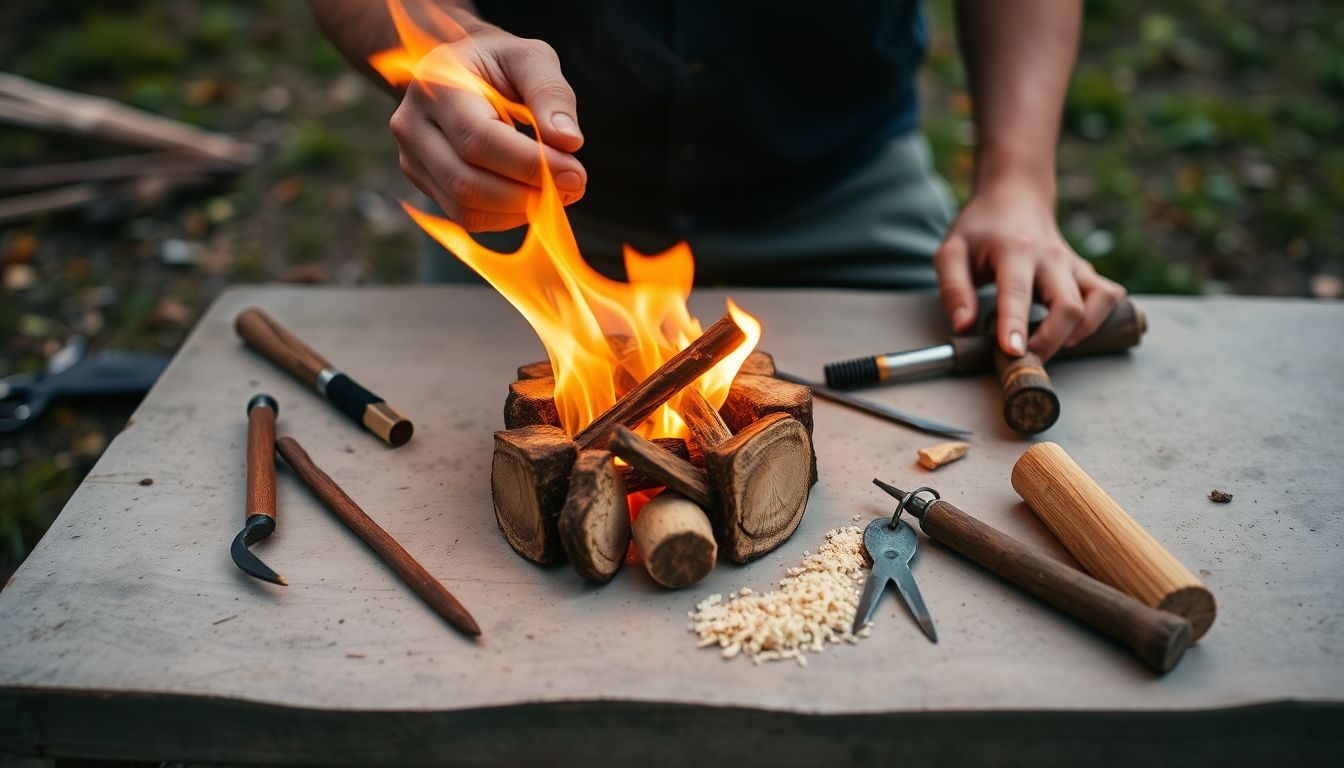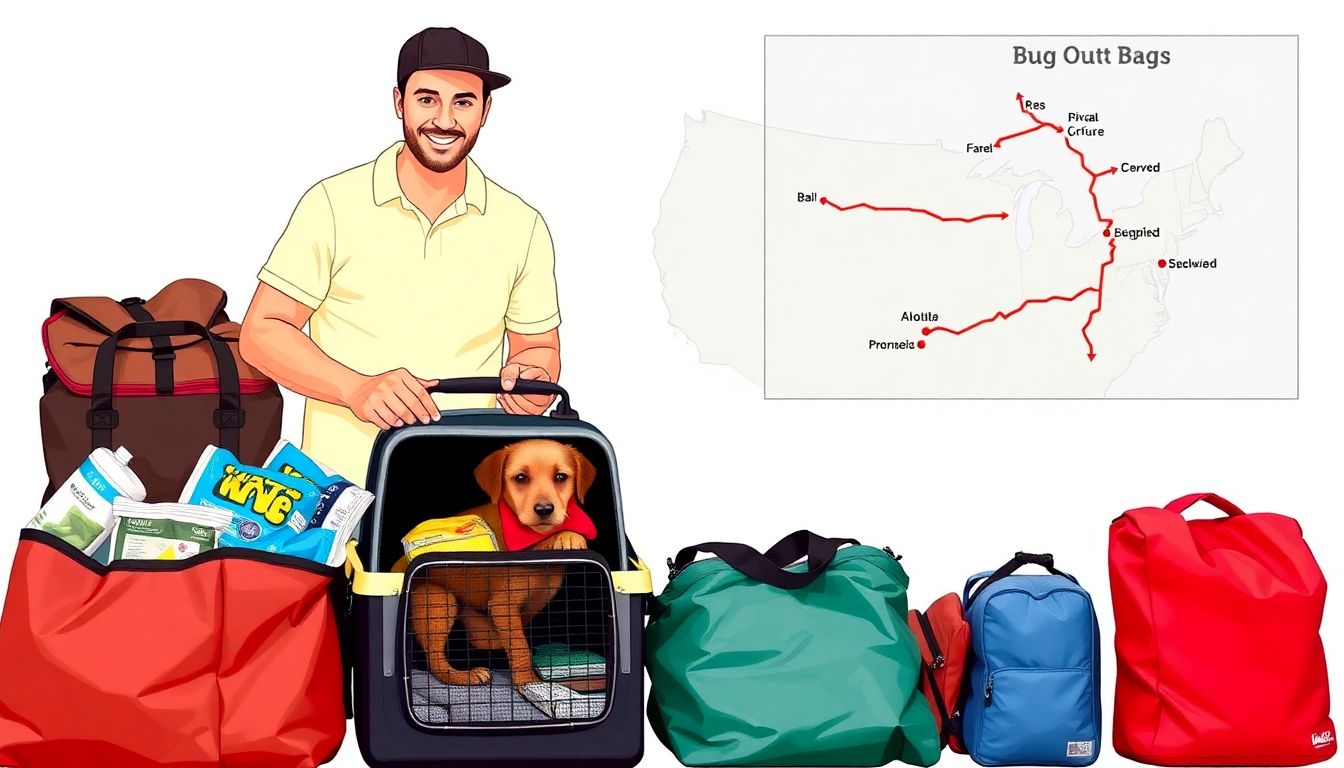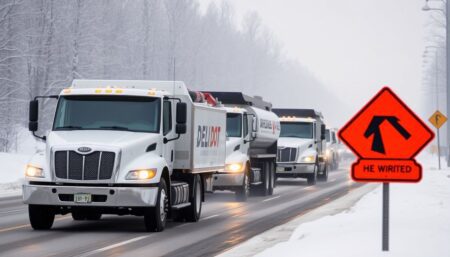Ever wondered what it would take to be ready for the unexpected? Whether it’s a sudden natural disaster, a city-wide blackout, or an unexpected evacuation, having a well-stocked bug-out bag, also known as a survival kit or emergency backpack, can mean the difference between a minor inconvenience and a major crisis. But with so many variables to consider, creating the ultimate bug-out bag can seem like a daunting task.
You’re not alone in feeling overwhelmed. According to a survey by the Red Cross, only 39% of Americans have an emergency supply kit, and even fewer have one that’s well-stocked and tailored to their specific needs. But what if we told you that with the right knowledge and a little bit of planning, you could create a bug-out bag that’s not only comprehensive but also tailored to your unique situation?
That’s exactly what we’re here to help you do. In this comprehensive guide, we’ll take you through the process of building your ultimate bug-out bag, step by step. We’ll start by helping you understand the purpose of a bug-out bag and what makes it different from other types of emergency kits. Then, we’ll dive into the nitty-gritty, providing you with a detailed checklist that covers everything from water and food to first aid supplies and tools. We’ll also help you tailor your bug-out bag to your specific needs, whether you’re a solo traveler, a family with young children, or someone with specific medical needs.
By the end of this article, you’ll have a clear understanding of what it takes to create a bug-out bag that’s not only comprehensive but also portable, durable, and ready to go at a moment’s notice. So, are you ready to take the first step towards preparedness? Let’s dive in and start building your ultimate bug-out bag today!
Equip, Prepare, Survive: Your Ultimate Bug-Out Bag Blueprint
Imagine this: the power grid goes down, a natural disaster strikes, or perhaps a sudden, unexpected event forces you to evacuate your home. In such scenarios, having a well-prepared bug-out bag can mean the difference between a minor inconvenience and a major catastrophe. This is where our ‘Equip, Prepare, Survive: Your Ultimate Bug-Out Bag Blueprint’ comes into play. We’re not talking about a mere backpack filled with random items; we’re talking about a meticulously crafted, life-saving kit that’s designed to keep you and your loved ones safe, comfortable, and self-sufficient for at least 72 hours. Think of it as your personal survival fortress, a portable sanctuary that ensures you’re ready to face any challenge that comes your way. So, let’s dive into the fascinating world of preparedness, where every item serves a purpose, and every decision counts. Together, we’ll explore the art of packing, the science behind survival essentials, and the peace of mind that comes with knowing you’re ready for whatever life throws at you. After all, fortune favors the prepared, and with our ultimate bug-out bag blueprint, you’ll be more than prepared
- you’ll be equipped, you’ll be ready, and you’ll be ready to survive.

Understanding Your Bug-Out Bag
Imagine this: you’re in the middle of a sudden, catastrophic event
- a wildfire, a hurricane, or an unexpected power outage. You have mere minutes to evacuate your home. What do you grab? This is where a well-prepared bug-out bag (BOB) comes into play. A bug-out bag is not your average backpack; it’s a lifeline, a portable survival kit designed to sustain you for 72 hours when faced with emergencies that require immediate evacuation. The concept of ‘bugging out’ might seem dramatic, but it’s a crucial aspect of emergency preparedness, especially in areas prone to natural disasters.
The primary purpose of a bug-out bag is to ensure your immediate survival and comfort during the initial hours of an emergency. It’s like a portable pantry, first aid kit, and survival guide all rolled into one. Unlike a regular backpack, which might contain books, laptops, or gym clothes, a bug-out bag is filled with essential items that can make the difference between safety and disaster. These items can range from non-perishable food and water to important documents, a first aid kit, a flashlight, and even a multi-tool.
But when do you ‘bug out’? The decision to evacuate should never be taken lightly, but sometimes, it’s the only safe option. If you’re in immediate danger, if authorities have issued evacuation orders, or if staying put puts you at greater risk, it’s time to grab your bug-out bag and leave. Remember, it’s always better to be safe than sorry. So, take the time to prepare your bug-out bag today. It could be the key to your survival tomorrow.
Here’s a simple breakdown of what your bug-out bag should contain:
- Water (one gallon per person per day)
- Non-perishable food (at least a three-day supply)
- Flashlight and extra batteries
- First aid kit
- Medications (seven-day supply)
- Multi-tool or pocket knife
- Map of the area (in case GPS doesn’t work)
- Whistle to signal for help
- Dust mask to help filter contaminated air
- Plastic sheeting and duct tape (for shelter)
- Local maps and a compass
- Cash (ATMs and credit card machines may not work)
- Important documents (insurance policies, IDs, birth certificates, etc.) in a waterproof container
- Extra set of clothes and rain gear
- Hygiene items (toilet paper, wet wipes, hand sanitizer)
- Pet supplies (if applicable)
- Copies of important keys

Choosing the Right Backpack
Choosing the right backpack is like finding your perfect travel companion
- it needs to be reliable, comfortable, and tailored to your needs. Let’s embark on this journey to find your ideal backpack, considering four key factors: size, durability, comfort, and features.
Firstly, size matters. Imagine trying to fit a square peg into a round hole
- it’s not comfortable, and it’s not going to work. The same principle applies to backpacks. If you’re a solo traveler, a 40-55L backpack should suffice for week-long trips. For families or those planning extended stays, consider a 65-85L backpack. Remember, a larger backpack means more space for stuff, but also more weight to carry.
Durability is next on our list. You don’t want your backpack to fall apart at the seams mid-trip. Look for robust materials like nylon or polyester, and check the stitching
- it should be even and strong. Reinforced bottoms and padded shoulder straps are also signs of a durable backpack.
Comfort is key, especially when you’re carrying your home on your back. A good backpack should have padded shoulder straps and a hip belt to distribute weight evenly. An adjustable torso length ensures a perfect fit, while a padded back panel prevents sweaty back syndrome. Try on your backpack with some weight in it to ensure it’s comfortable.
Finally, let’s talk features. Do you need a hydration bladder port, or a laptop sleeve? How about external pockets for easy access to essentials? Some backpacks even have rain covers or sleeping bag compartments. Consider what features would make your travels smoother.
Now, let’s look at some recommendations:
- For solo travelers, the Osprey Farpoint 40 is a popular choice, offering a balance of size, durability, and comfort, along with a detachable daypack.
- Families might appreciate the Gregory Baltoro 65, with its generous size, excellent ventilation, and numerous pockets.
- If you’re on a budget, the Teton Sports Explorer 4000 is a durable and comfortable option, offering great value for money.
Happy backpack hunting!

The 72-Hour Rule: Packing Essentials
The 72-hour rule is a crucial survival guideline that recommends packing enough supplies to sustain you for at least three days. This rule is not arbitrary; it’s based on the ‘rule of threes,’ a survival principle that prioritizes your most immediate needs. Here’s why it’s so important and how you can apply it to your packing.
The ‘rule of threes’ is a simple yet powerful concept that helps you prioritize your survival needs. It states that you can survive:
- Three minutes without air (or oxygen)
- Three hours without shelter (in extreme temperatures)
- Three days without water
- Three weeks without food
This rule emphasizes the importance of addressing these needs in this order. So, when packing for a potential emergency, you should focus on these three days’ worth of supplies.Now, let’s break down what you should pack according to the 72-hour rule. Remember, the goal is to have enough supplies to keep you safe, comfortable, and healthy for three days.
- Water: Aim for one gallon per person per day. This is your top priority, as dehydration can set in quickly.
- Food: Pack non-perishable, high-energy foods. You’ll need around 2,000 calories per day.
- Shelter: This could be a tent, a tarp, or even a large trash bag. Protection from the elements is crucial.
- Clothing: Pack layers to adapt to changing temperatures. Include a hat, gloves, and rain gear.
- First Aid Kit: Injuries can happen at any time, so it’s essential to have a well-stocked first aid kit.
- Light and Fire: A flashlight, extra batteries, and a way to start a fire (matches, lighter, or firestarter) are vital.
- Communication: A whistle, a fully charged cell phone, and a portable charger can help you stay connected.
Following the 72-hour rule and the ‘rule of threes’ can significantly improve your chances of survival in an emergency. It’s a simple yet effective way to prioritize your needs and pack accordingly. So, the next time you’re preparing for a trip or an emergency, remember the 72-hour rule and the ‘rule of threes.’ It could make all the difference.

Water: The Most Vital Resource
Water, the most vital resource on Earth, is not just a necessity for life, but a lifeline in survival situations. In such circumstances, it’s crucial to understand how much water to pack and how to ensure its purity. The rule of thumb is to carry at least one gallon of water per person per day, accounting for drinking, cooking, and hygiene. However, this can vary greatly depending on factors like climate, physical exertion, and individual needs.
Purifying water is a vital skill to master. Boiling is the most reliable method, requiring water to be brought to a rolling boil for at least one minute (or three minutes at higher altitudes). Alternatively, chemical treatments like iodine or chlorine dioxide tablets can be used, following the manufacturer’s instructions. Filtration using a portable water filter is another option, but it’s important to note that while it removes particles, it may not kill all viruses and bacteria.
In addition to carrying water in traditional bottles, consider using collapsible bottles and water pouches. These are lightweight, take up less space when empty, and can be easily packed in backpacks or emergency kits. Some even come with built-in filters or purification systems. Another option is to use water bladders, which can hold large quantities of water and are often used in camping and hiking scenarios.
Remember, water is not just about drinking. It’s also crucial for cooking, cleaning, and maintaining personal hygiene. Always prioritize water in your survival planning, and consider all the ways you might need to use it. After all, as the old saying goes, ‘You can survive for weeks without food, but only days without water.’

Food: Energy for Survival
When it comes to ensuring our survival, food is not just a pleasure, but a necessity. It’s the energy that fuels our bodies and minds, keeping us going through challenging times. That’s why, when preparing a bug-out bag, selecting the right non-perishable, high-energy food items is crucial. These items should be lightweight, compact, and packed with calories to sustain you during an emergency situation.
First, let’s discuss meal planning. A balanced diet is key, even in survival situations. Aim for a mix of carbohydrates, proteins, and fats. Carbohydrates provide quick energy, proteins help build and repair tissues, and fats offer sustained energy and essential fatty acids. Consider including items like:
- Rice and pasta, which have a long shelf life and are high in carbohydrates.
- Canned meats, like tuna or chicken, for protein.
- Nuts and seeds, which are high in healthy fats and calories.
- Energy bars or granola bars for a quick energy boost.
Portion control is also vital. It’s tempting to pack more food than you need, but remember, every ounce counts when you’re carrying your bug-out bag. A good rule of thumb is to pack enough food for one meal per person, per day, plus an extra day’s worth of food as a backup. Also, consider using resealable bags to portion out meals in advance.
But what if your food supply runs out? That’s where alternative food sources come in. Fishing gear and snares can help you catch wild game or fish, providing a sustainable food source. However, always remember to respect local wildlife and follow ethical hunting and fishing practices. It’s also important to know how to prepare and cook these foods safely to avoid illness.
Lastly, don’t forget to rotate your food supply regularly. Check your bug-out bag every few months and replace any items that are nearing their expiration date. This will ensure your food is always fresh and ready to go when you need it most.
In conclusion, selecting the right food for your bug-out bag is a balancing act of nutrition, energy, and weight. With careful planning and consideration, you can create a food supply that will sustain you through any emergency situation.

Shelter and Warmth
In the grand tapestry of survival, few threads are as crucial as shelter and warmth. These aren’t mere creature comforts; they’re lifelines that can mean the difference between a harrowing ordeal and a tragic outcome. When faced with unexpected circumstances, our bodies can lose heat up to 25 times faster when wet, making shelter and warmth not just luxuries, but necessities.
Shelter options run the gamut from lightweight to robust, each with its own merits. At one end of the spectrum, tents offer a quick, portable solution. They’re designed to keep the elements at bay, providing a safe haven from rain, wind, and snow. On the other end, there are emergency blankets and bivy sacks. These are lightweight, packable, and can trap your body heat, reflecting it back to you. They’re not spacious, but they can save lives in a pinch.
But what if you find yourself without these tools? Fear not, for nature’s pantry is deep. Here are some tips for creating makeshift shelters using natural materials. First, find a long, sturdy branch and lean it against a tree or a large rock. This will serve as the backbone of your shelter. Next, gather smaller branches and weave them together, creating a lattice that will support debris. Now, the fun begins. Collect leaves, pine needles, and other soft materials to pile on top of your lattice. The thicker the layer, the better it will insulate you from the cold. Finally, line your shelter with more debris, creating a cozy bed to protect you from the ground.
Remember, the goal is to create a barrier between you and the elements, trapping your body heat and keeping you dry. It’s not about building a palace, it’s about creating a sanctuary. So, the next time you find yourself in a survival situation, don’t despair. Look around, get creative, and let nature be your architect.

Clothing and Footwear
When compiling your bug-out bag, selecting the right clothing and footwear is as crucial as choosing the essentials you’ll carry. Your attire should be versatile, durable, and most importantly, suitable for the environment and activities you’ll encounter. Let’s delve into the key factors to consider when dressing for your bug-out bag.
The first step is to assess the weather conditions and terrain you might face. If you’re preparing for a cold-weather scenario, invest in moisture-wicking base layers to keep you warm and dry. These can be made of materials like wool or synthetic fabrics. Next, add insulating layers such as fleece or down jackets. Don’t forget to protect your extremities with warm socks, gloves, and a hat.
For hot-weather conditions, opt for lightweight, breathable fabrics like cotton or linen. These materials allow sweat to evaporate, keeping you cool. Also, consider wearing long sleeves and pants to protect your skin from the sun and insects.
Layering is a vital concept in packing for any situation. It allows you to adjust your clothing to suit changing temperatures throughout the day. Start with a base layer, add insulating layers as needed, and top it off with a waterproof or windproof outer layer to protect against the elements.
Footwear is another critical aspect. Choose shoes or boots that are comfortable, durable, and provide good ankle support. For cold weather, consider insulated boots, and for hot weather, opt for breathable, quick-drying materials. Always ensure your footwear is broken in before you need to use it to prevent blisters.
Lastly, consider your activity level. If you’ll be hiking or moving around a lot, opt for clothing that allows for a full range of motion. Also, pack extra socks to change into if your feet get wet or sweaty.
By considering these factors and packing accordingly, you’ll be well on your way to creating a comprehensive bug-out bag that caters to your clothing and footwear needs.

First Aid and Medical Supplies
In the face of a survival situation, a well-stocked first aid kit can mean the difference between life and death. It’s not just about having bandages and antiseptic; it’s about being prepared to handle a wide range of injuries and illnesses that could arise in a crisis. A comprehensive first aid kit is your first line of defense, providing immediate care until professional medical help can be obtained.
The importance of a well-stocked first aid kit cannot be overstated. It’s not just about treating minor cuts and scrapes; it’s about being ready to handle major injuries, stabilize a victim until medical help arrives, and even treat common illnesses that could exacerbate an already stressful situation.
So, what should you include in your first aid kit? Here’s a comprehensive list:
- Adhesive bandages in various sizes
- Gauze pads and rolls
- Adhesive tape
- Antiseptic wipes or solution
- Antibiotic ointment
- Pain relievers (ibuprofen, acetaminophen)
- Allergy medication (antihistamines)
- Hydrocortisone cream
- Tweezers and scissors
- Thermometer
- Emergency blanket
- CPR mask
- Instant cold packs
- Safety pins
- Gloves
- First aid manual
- Prescription medications (if applicable)
But having the right supplies is only half the battle. Knowing how to use them is just as important. Here are some tips on administering first aid and treating common injuries and illnesses:
- Always wash your hands before treating a wound to prevent infection.
- For cuts and scrapes, clean the wound, apply pressure to stop bleeding, and cover with a bandage.
- For burns, cool the burn with cool (not cold) water, cover with a sterile, non-adherent bandage, and elevate the injured area.
- For sprains and strains, use the RICE method: Rest, Ice, Compression, Elevation.
- For allergic reactions, administer antihistamines and, if severe, seek immediate medical help.
- For hypothermia, warm the victim gradually, provide warm drinks, and seek medical help if symptoms worsen.
- For heat exhaustion, move the victim to a cooler place, hydrate, and cool them down with wet cloths or a shower.
Remember, the goal of first aid is to provide immediate care, prevent further harm, and buy time until professional medical help can arrive. It’s a crucial skill set to have in any survival situation. So, stock up, stay informed, and stay safe!

Fire Starting and Lighting
In the vast expanse of the wilderness, fire is not just a comforting campfire, but a lifeline, a beacon of hope in a survival situation. Its importance is multifold
- it provides warmth, a means to cook food, and serves as a crucial signaling tool. In the cold, it can mean the difference between life and hypothermia; in the dark, it can be a source of light and security; and in the wild, it can signal for help, attracting rescuers from miles away.
To harness this power, one must first understand the art of fire starting and lighting. There are numerous methods and tools at one’s disposal, each with its own set of advantages and challenges. The most basic and reliable method is the use of matches or lighters. However, these should be used sparingly, as they are finite resources.
For a more sustainable approach, consider the following methods:
- Friction-based methods: The bow drill, hand drill, and fire plow are ancient techniques that use friction to create an ember. They require practice and patience, but once mastered, they can be incredibly rewarding.
- Flint and steel: This method involves striking a piece of flint against a steel rod to create sparks. It’s simple, reliable, and can be used in most weather conditions.
- Magnifying glass: On a sunny day, a magnifying glass can focus the sun’s rays onto a small pile of tinder, igniting it.
- Battery and steel wool: Rubbing a piece of steel wool against the terminals of a battery can create enough heat to ignite tinder.
Regardless of the method chosen, the success of a fire depends largely on the tinder and fuel gathered. Tinder should be dry, combustible material that catches fire easily, such as dry leaves, pine needles, or birch bark. Fuel, on the other hand, should be anything from small twigs to large logs, depending on how long you want your fire to burn.
Preparing tinder involves breaking it down into smaller pieces to increase its surface area and make it easier to ignite. Fuel should be stacked in a specific way to ensure a steady burn. The ‘teepee’ method is a common technique, where small twigs are arranged in a teepee shape over the tinder, allowing oxygen to flow and the fire to grow.
In conclusion, fire is a vital skill in a survival situation. With the right knowledge, tools, and preparation, it can be harnessed to provide warmth, cook food, and signal for help. So, the next time you’re in the wilderness, remember the power of fire, and respect the art of fire starting and lighting.

Navigation and Communication
In the vast, unpredictable expanse of the wilderness, two skills stand out as indispensable for survival: navigation and communication. These are not mere luxuries, but lifelines that can mean the difference between a successful journey and a harrowing ordeal.
Navigation, the art of finding one’s way, is the first step in ensuring a safe and efficient journey. It allows us to plan our route, avoid hazards, and reach our destination. The tools of navigation are as varied as they are crucial. Maps, with their detailed terrain and landmarks, provide a bird’s-eye view of our journey. They are static, but their information is invaluable. Compasses, on the other hand, are dynamic, pointing us in the right direction regardless of where we are on the map. They are simple, reliable, and should be a staple in every survival kit. GPS devices, with their real-time tracking and digital maps, offer unparalleled precision. However, they rely on batteries and satellites, making them less reliable in remote areas or during emergencies.
Communication, the ability to connect with others, is equally vital. It allows us to call for help, share our location, and coordinate with others. Emergency radios, with their weather alerts and ability to pick up signals from rescue services, can be literal lifesavers. Satellite phones, with their global coverage and ability to make calls even in the most remote locations, provide a direct line to the outside world. However, they are expensive and require a clear line of sight to the sky.
In a survival situation, these tools are not luxuries, but necessities. They are the means by which we orient ourselves in the wilderness, find our way back to safety, and connect with the world beyond. They are the tools that turn a daunting challenge into a manageable task, a harrowing ordeal into a triumphant journey.

Self-Defense and Protection
In the vast, unpredictable tapestry of life, the importance of self-defense and protection cannot be overstated, especially in survival situations. Being prepared and knowledgeable can mean the difference between a harrowing ordeal and a successful resolution. Let’s delve into the critical aspects of self-defense, starting with situational awareness, the first line of defense.
Situational awareness is like having a sixth sense, constantly scanning your environment for potential threats. It’s about being present, observant, and proactive. Here are some steps to enhance your situational awareness:
- Keep your head up and eyes forward, avoiding distractions like phones or headphones.
- Pay attention to your surroundings, noting exits, potential weapons, and people around you.
- Trust your instincts; if something or someone makes you uncomfortable, remove yourself from the situation.
Prevention is always better than cure, so avoiding dangerous situations is paramount. This involves staying in well-lit, populated areas, especially at night, and avoiding isolated or poorly lit places. It’s also crucial to let someone know your whereabouts and expected return time.
Non-lethal self-defense tools can be invaluable when faced with a threat. Pepper spray and stun guns are popular choices. Pepper spray, when aimed at the eyes, can temporarily incapacitate an attacker, giving you time to escape. Stun guns, on the other hand, deliver a powerful electric shock, causing muscle contractions and disorientation. Always remember to:
- Carry your self-defense tool in an easily accessible location.
- Familiarize yourself with its use and maintain it properly.
- Use it confidently and decisively if needed, aiming for the most effective target areas.
While non-lethal tools are preferred, sometimes the responsible use of firearms may be necessary for self-defense. If you choose to carry a firearm, it’s crucial to:
- Obtain proper training from certified instructors.
- Understand and follow all local laws and regulations.
- Practice regularly to maintain proficiency.
- Store your firearm securely when not in use.
Remember, a firearm is a tool, not a solution. It should only be used as a last resort when all other means of escape have been exhausted.
In conclusion, self-defense and protection are not just about fighting back; they’re about staying safe, being aware, and making smart decisions. It’s about being proactive, not reactive. It’s about understanding your environment, your tools, and your capabilities. It’s about being prepared, because in a survival situation, preparation can be your greatest ally.

Maintenance and Upkeep
Maintaining and updating a bug-out bag is a crucial task that ensures you’re always prepared for unexpected emergencies. Let’s dive into some essential tips to keep your bag in top shape and ready for use.
Firstly, let’s talk about food and water supplies. Rotating these items is key to preventing spoilage and ensuring you have fresh supplies when you need them. Aim to replace your food and water supplies every six months. This way, you’re consistently updating your bag with new, unexpired items. Remember to store your food in airtight containers and keep them in a cool, dry place to extend their shelf life.
Next, let’s address the importance of checking expiration dates on your medical supplies. Medications, first aid kits, and other medical items have expiration dates for a reason. Outdated supplies can be ineffective or even harmful. Make it a habit to check these dates every time you rotate your food and water supplies. If anything is expired, replace it immediately.
Now, let’s talk about testing your gear. It’s not enough to simply pack your bag and forget about it. Regular testing ensures that everything in your bag is in working order and ready to use. Here are some steps to follow:
- Test your flashlight or headlamp to ensure the batteries are working and the light is bright.
- Check your multi-tool, knife, and other tools to make sure they’re sharp and functional.
- Inspect your fire-starting materials, such as matches or lighters, to ensure they’re still usable.
- Test your communication devices, like a whistle or two-way radios, to make sure they’re working.
Remember, the goal is to make sure every item in your bag is ready to use at a moment’s notice.
Lastly, consider updating your bug-out bag based on changes in your life or environment. If you’ve moved to a new area, you might need to add or remove items based on the new climate or potential hazards. If you’ve gained or lost family members, you might need to adjust the size or contents of your bag. Regularly reviewing and updating your bag ensures it’s always tailored to your specific needs.
By following these tips, you’ll ensure that your bug-out bag is always ready for use, providing you with the peace of mind that comes with being prepared.

Special Considerations for Families and Pets
Preparing a bug-out bag for families, especially those with children and pets, presents unique challenges that require careful planning and consideration. Unlike a standard emergency kit, a family bug-out bag must account for the specific needs of each member, ensuring everyone has what they need to stay safe, comfortable, and entertained during an unexpected situation.
Firstly, let’s consider the little ones. Infants and toddlers have specific dietary requirements, so it’s crucial to pack enough formula, baby food, and bottles. Don’t forget to include any medications they might need, along with a first aid kit designed for children. For older kids, pack a variety of non-perishable snacks and drinks to keep their energy up.
Now, let’s not forget our furry, feathered, or scaled family members. Pets rely on us for their survival, so it’s essential to pack enough food and water for them, as well as any necessary medications and a copy of their vaccination records. Don’t forget to include a leash, collar, and ID tags, as well as any comfort items like their favorite toy or blanket.
Entertainment is another critical aspect to consider, especially for kids. Pack a variety of age-appropriate activities like books, puzzles, or travel games to keep them engaged and distracted during stressful situations. Don’t forget to include a portable charger or backup battery for electronic devices, as these can be a lifeline for both kids and adults alike.
Lastly, it’s important to involve the whole family in the packing process. This not only helps ensure everyone’s needs are met but also provides an opportunity to educate children about emergency preparedness. Make it a fun activity, turning it into a game or a scavenger hunt to keep everyone engaged and excited.
Remember, the key to a successful family bug-out bag is to tailor it to your family’s unique needs and circumstances. With a little planning and preparation, you can ensure that everyone, including your beloved pets, is ready to face any unexpected situation that comes your way.
FAQ
What is a Bug-Out Bag and Why Do I Need One?
What Should I Consider When Choosing a Bug-Out Bag?
- Size: A 50-65 liter bag is typically ideal for a Bug-Out Bag, providing enough space for essentials without being too bulky.
- Comfort: Ensure the bag has padded, adjustable straps for comfortable carrying, especially if you’ll need to walk long distances.
- Durability: Invest in a bag made of sturdy, water-resistant material that can withstand harsh conditions.
- Organization: Look for a bag with multiple compartments and pockets to help you keep your gear organized.
- Color: Consider a bag in a neutral color to help you blend in with your surroundings if discretion is necessary.
What Are the Essential Items to Include in My Bug-Out Bag?
- Water: Aim for at least one gallon per person per day. Include a water filter or purification tablets as well.
- Food: Pack non-perishable, high-energy foods like canned goods, energy bars, and dried fruits. Don’t forget a manual can opener!
- Shelter: A tarp, emergency blanket, or tent can provide protection from the elements.
- Clothing: Pack layers suitable for the season, including a rain jacket and extra socks.
- First Aid: A well-stocked first aid kit is crucial for treating injuries and illnesses.
- Lighting: Include a flashlight, headlamp, and extra batteries. Glow sticks can also be useful.
- Communication: A fully charged cell phone, portable charger, and a whistle for signaling for help.
- Tools: A multi-tool, knife, and duct tape can be invaluable in various situations.
- Hygiene: Pack toilet paper, wet wipes, hand sanitizer, and personal hygiene items.
- Important Documents: Keep copies of important documents like IDs, insurance policies, and emergency contact information in a waterproof container.
- Cash: Have some cash on hand, as ATMs and credit card machines may not be functioning.
How Do I Pack My Bug-Out Bag for Easy Access?
- Use clear, resealable plastic bags to group related items together and keep them dry. Label each bag with its contents.
- Place frequently used items in easily accessible pockets or at the top of the bag.
- Use packing cubes or stuff sacks to keep your gear organized and maximize space.
- Pack heavier items close to your back and towards the bottom of the bag for better balance.
- Consider using a separate, smaller bag or pouch for essential items you may need to grab quickly, like your wallet, phone, and important documents.
How Do I Prepare My Bug-Out Bag for Different Seasons?
- Summer: Pack light, breathable clothing, a wide-brimmed hat, sunscreen, and insect repellent. Include extra water to stay hydrated in hot temperatures.
- Winter: Add warm clothing layers, insulated gloves, a hat, and waterproof boots. Include hand and toe warmers, and pack high-energy foods to help maintain your body heat.
- Spring/Fall: Pack versatile clothing layers that can adapt to changing temperatures. Include rain gear and consider packing a small camp stove for warmth and cooking.
Additionally, always check the weather forecast before leaving and adjust your gear accordingly.
How Often Should I Review and Update My Bug-Out Bag?
- Expiration dates: Replace any food, water, or medication that has expired.
- Condition of gear: Inspect your gear for any signs of wear or damage, and replace as needed.
- Seasonal adjustments: Update your clothing and other items to suit the current season.
- Changes in your life: Add or remove items based on changes in your family composition, living situation, or personal needs.
- Local threats: Research and prepare for any new or evolving threats in your area, such as wildfires, floods, or pandemics.
It’s also a good idea to practice using the items in your bag to familiarize yourself with how they work and ensure everything is in good working order.









